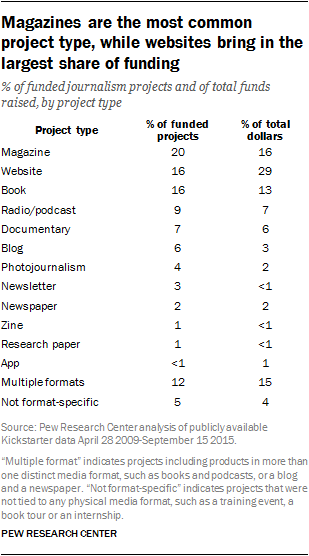 Projects funded through Kickstarter represent a growing trend in covering the news that truly matters to readers.
Projects funded through Kickstarter represent a growing trend in covering the news that truly matters to readers.
As major news outlets grow more and more entrenched in the sound-bite, always-on news cycle, there is a small but growing trend toward publicly funded journalism projects.
“Over the past several years, crowdfunding via the internet has become a popular way to engage public support – and financial backing – for all kinds of projects, from the Coolest Cooler to a virtual reality gaming headset to a prototype of a sailing spacecraft and a bailout fund for Greece,” write Nancy Vogt and Amy Mitchell in Journalism.org. “The area of journalism is no exception.”
“From April 28, 2009 to September 15, 2015, 658 journalism-related projects proposed on Kickstarter, one of the largest single hubs for crowdfunding journalism, received full – or more than full – funding, to the tune of nearly $6.3 million,” they continue.
We talked about crowdfunded journalism back in 2014, when The Huffington Post took to crowdfunding site Beacon to fund in-depth coverage of the racial conflicts in Ferguson, MO. The interest in this kind of reporting has only increased since then, according to Pew Research Center stats cited in the article.
“In today’s evolving digital era, it represents a new, niche segment of nontraditional journalism driven in large part by public interest and motivation,” the article continues. “It is bringing voice and visibility to efforts that would likely otherwise go unnoticed or unfunded, adding yet another way for the public to engage in creating, funding and disseminating journalism and adding one more option to the arsenal of revenue sources that the industry is desperately seeking to build up.”
While the Ferguson story was sponsored by a major media brand, the majority of journalism projects being funded are not from big or well-known names in media.
Media organizations like Huffington Post and other were behind about one in five projects (22%), but individuals or small groups of individuals accounted for 72% of funded journalism projects; institutions, including non-profits and educational entities, accounted for 7%.
We’ve seen plenty of evidence of niche magazine feeling the Kickstarter love, as readers are increasingly drawn to specialty content that resonates within their own tribe. As the connected consumer explores the vast possibilities for news and connection out there, increasingly it seems that publicly funded long-form journalism is emerging as the counterpoint to the sound bite news that saturates our online experience.
“Across these categories, one feature that stands out – and goes against much of today’s focus on second-by-second news updates – is longer-form journalism, which tends to also take a broader, more in-depth look at news events,” the article continues. “Magazine-related work, books and documentaries together accounted for 43% of projects funded by the public.”
Journalism has been disrupted in the digital age, in ways both insidious and compelling. In our age of peak content – some predict the attention economy is about to collapse under its weight – publicly funded journalism offers a real opportunity for editors and journalists to connect with readers in ways that truly benefit both.

October 4, 2016, 2:54 pm
November 10, 2020, 12:21 pm